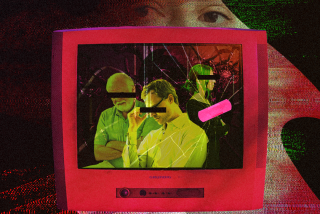‘Bride’ Walks Down Aisle of Stereotyping
- Share via
Hollywood screenwriters often resort to stereotypes when introducing characters of foreign origin. Perhaps this is due to the fact that using stereotypes allows the story to unfold quickly and get its point across without having to work out too much of a dialogue; however, when most portrayals of Arabs and Muslims in movies are only stereotypes, something has got to be terribly wrong.
Beginning with Michael Curtiz’s “Casablanca,” and Hitchcock’s “The Man Who Knew Too Much,” Hollywood has tended to focus on the exotic, the sensational and the downright inaccurate when it dealt with Arab and/or Muslim characters. Arabs and Muslims are nowadays constantly stereotyped as violent terrorists, conniving businessmen or uneducated oil magnates.
The latest example of this ethnic caricaturing is Charles Shyer and Nancy Meyers’s re-write of “Father’s Little Dividend,” itself a sequel to the original “Father of the Bride.” In the aptly titled “Father of the Bride-Part II,” the screenwriters resort to the most blatant cultural debasement in order to get cheap laughs from their audience.
Consider this: In the four minutes of screen time allotted to him in this Touchstone comedy, Mr. Habib, an un-shaven, cigarette-smoking, coarse-looking fella, manages to verbally abuse his wife, litter the garden and sell their home back to the Bankses, for $100,000 more than what he bought it for!!
Not a small feat, probably supplanted only by 20th Century Fox’s “True Lies,” which has garden-variety Arab terrorists conveniently brandishing their fists and shouting “Allahu Akbar.” Aziz, their leader, is (yes) an un-shaven, coarse-looking psychopath out to steal ex-USSR nuclear weapons, when Arnold Schwarzenegger tries to stop him. The scary part is that, despite the avalanche of complaint letters which Fox received, the studio’s reaction amounted to putting a disclaimer after the closing credits.
And who could forget Disney’s “Aladdin?” It was great that the studio had finally chosen a Middle-Eastern tale of power and courage, which would naturally serve as an introduction to Arab and Muslim culture. Of course, there was the infamous line, which went something like, “Arabian land/where they cut your ear/if they don’t like your face.” It took all the persuasion of anti-defamation organizations to get Disney to keep it out of the video version. Yet I can’t help but notice that this version still still has the narrator referring to “home” as “barbaric.” If Hollywood screenwriters portray Arab men as Muslim fundamentalists, they prefer the battered woman cliche for Arab women. In “Baby Boom,” one of the baby sitters whom Diane Keaton interviews shows up entirely veiled in black, and whispers softly, “I’ll teach your daughter how to respect a man. I only speak when I’m spoken to.” And in “Never Without My Daughter,” that is indeed what female characters did, when they were not physically or psychologically abused by other male characters.
If this list strikes you as singling out only a few feature films, then you should take a look at “Navy Seals,” “Iron Eagle,” “Back to the Future,” “Patriot Games” and any Chuck Norris movie. This is a much more general phenomenon than most people think, and its consequences can only be the dehumanization of Arabs and Muslims as a religious, cultural and ethnic group.
By their nature, stereotypes rely on fact more than fiction.
* Here is the fiction: Arabs are Muslims. Here is the fact: Although most Arabs are probably Muslims, most Muslims are not Arabs. But when did you ever see a Muslim from Malaysia, Indonesia, Brunei, the Philippines or France in a movie?
* Fiction: Women are mistreated in Arab countries. Fact: There are proportionately more domestic incidents each year in the United States than in Arab countries.
* Fiction: Women have no rights in the Muslim World. Fact: More women have served in the Iranian parliament than in the Israeli Knesset.
The bottom line is this: We’ve seen enough movies with Arabs and Muslims as the terrorists de service, the cartoonish characters wearing a keffieh, the ignorant and uneducated businessmen making fools of themselves in cocktail parties. It’s now time to see them as the average human beings they are, leading normal lives, buying milk at the grocery store, getting Chinese take-out or shopping in malls. Is that too much to ask?



